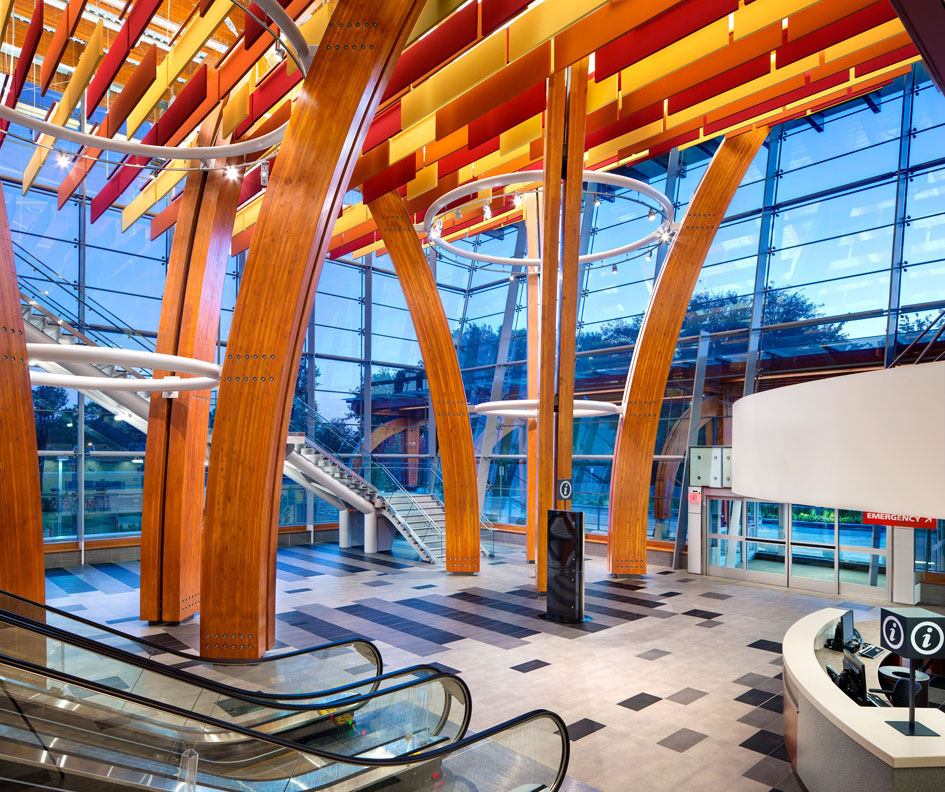Research is confirming what many already inherently know: being exposed to nature — and natural organic materials — not only calms one’s mind, it may also have a role in preventing and treating disease.
“We are wired to recognize things in nature that benefit us,” said David Fell, former research leader at FPInnovations. “For most of our evolution, humans have had a close relationship to trees and wood, so it’s only natural that its visible presence has a positive effect on our well-being.”
Our positive response to wood suggests it’s a good choice for health-care environments. It’s also considered hypoallergenic, as its smooth surfaces are easy to clean.
Wood harvested from sustainably managed forests provides high-quality design solutions. It’s well-suited for economical and timely construction — notably in hard to reach places, including downtown sites and remote locations.
An increasing number of health-care facilities are making use of wood in their buildings to bring a warm, natural aesthetic.

Visitors to Surrey Memorial Hospital are greeted by exposed structural timbers, panelling,
and millwork, creating the impression the ceiling is being held up by trees.
Photo: Ed White Photographics
At Surrey Memorial Hospital’s emergency department and critical care tower, tree-like wood columns greet visitors and patients, each consisting of four thick glue-laminated timber (glulam) “branches” that extend from floor to ceiling. They support a panelized atrium roof. Wood products and finishes are used for the millwork, interior walls, and acoustic panelling to help control airborne contaminants. HDR | CEI Architecture Associates and Parkin Architects (joint venture) used wood in the design to soften the institutional feel at the hospital, and create a calm, stress-reducing connection to nature.
Providing a home away from home for 70 families receiving treatment at the B.C. Women’s and Children’s Hospital in Vancouver, the Ronald McDonald House BC and Yukon makes ample use of wood to bring a comfortable, nurturing character and sense of community to the four houses. The project is an advanced application of mass-timber construction, built of a hybrid cross-laminated-timber (CLT) wall and high-performance light-wood floor system. Panelized construction allowed for off-site prefabrication. The building, conceived by Mcfarlane Green Biggar Architecture + Design and completed by MGA | Michael Green Architecture, is the first in the world to use tilt-up CLT and light-wood-frame building system designed for a 100-year service life — setting a new benchmark for robust, cost-effective, institutional-grade timber construction.
The dramatic design of the Kitsumkalum Health Centre is striking. One of the 14 First Nations that make up the Tsimshian Nation, the Kitsumkalum’s architectural tradition of building impressive longhouse structures inspired the sleek and chiselled all-wood design of the northern B.C. health centre. Designed by Lubor Trubka Associates Architects, the building’s roof uses conventional prefabricated triangular roof trusses installed upside down, and its substantial overhang discourages snow accumulation close to the building. The health centre is located in the heart of the community’s traditional territory at the juncture of the Skeena and Kalum Rivers.
In Prince George, The Canadian Cancer Society Kordyban Lodge, designed by NSDA Architects, is a distinctively non-institutional timber-framed lodge that provides a comfortable place to stay for people receiving medical treatment at the nearby cancer facility. The hybrid-timber structure is framed with engineered Douglas-fir, light-wood frame prefabricated wall panels, and engineered roof-trusses. The entrance canopy is built of glulam columns and beams, paired purlins and exposed wood decking.
These projects and others are featured in a newly released book, Naturally Wood, which showcases British Columbia’s cutting‐edge wood architecture and design. The beautifully illustrated, 160-page publication contains more than 65 innovative wood buildings and projects, including how wood is being used in health and wellness.
Four continuing education units have been developed based on the book. They are recognized by the Architectural Institute of British Columbia and are available at naturallywood.com/naturally-wood-ceus.
Download the Naturally Wood e-book at naturallywood.com/nwbc.











That’s really nice post. I appreciate your skills, Thanks for sharing.